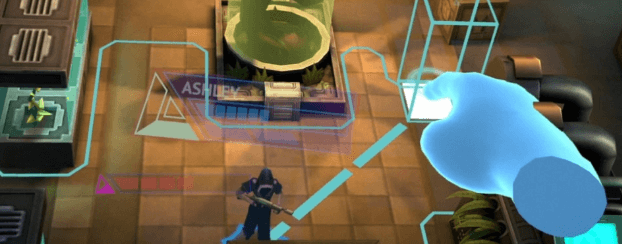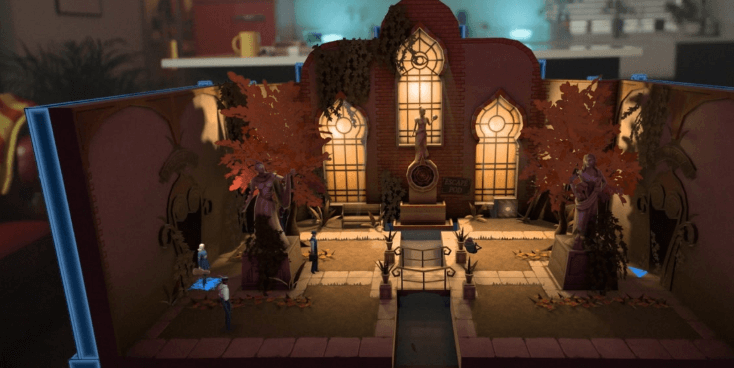March 2025 isn’t just about gadgets like Razer’s toasty Blade 16 or Hypershell’s cliff-climbing exoskeletons—it’s a milestone for immersive gaming. Augmented Empire redefines turn-based strategy by merging cyberpunk storytelling with mixed reality (MR), transforming your living room into a neon-drenched battlefield. Imagine planning heists against megacorps while holographic drones hover over your coffee table—this isn’t just a game; it’s a tech manifesto.
Blurring Realities in Tactical Gaming
Why now? The RTX 5090 and Radeon RX 9070 XT GPUs—barely keeping pace with 2025’s graphical demands—enable Augmented Empire’s seamless MR integration. Unlike VR headsets that isolate players, MR layers dystopian cityscapes onto physical spaces, letting you manipulate holographic interfaces with real-world gestures. It’s tactical depth meets visceral presence—a leap beyond flat screens or clunky motion controls.

But relevance isn’t just about hardware. Cyberpunk’s themes of corporate dominance and human augmentation resonate in an era where AI ethics dominate headlines. Augmented Empire doesn’t just let you fight dystopia—it makes you inhabit it. Ready to see why your next strategy session might involve rearranging furniture?
Tactical Depth in a Holographic Playground
Augmented Empire’s mixed reality (MR) isn’t a gimmick—it’s a gameplay revolution. Unlike traditional turn-based games where maps are static grids, here, your physical environment dictates strategy. A bookshelf becomes cover; a hallway transforms into a chokehold. The game uses LiDAR scanning to adapt levels to your room’s layout, forcing players to rethink positioning dynamically. Gizmodo’s March 2025 roundup notes MR’s rise, but no title integrates it as ruthlessly—fail to clear clutter, and a holographic sniper might exploit that laundry pile as a blind spot.
Combat hinges on “Reality Synergy,” a system where environmental interactions amplify abilities. Hack a virtual terminal on your real desk to disable enemy drones, or use a floor lamp as a conduit for EMP bursts. The Radeon RX 9070 XT’s 3.3 GHz undervolted clock speeds (per VideoCardz) enable these real-time physics calculations without latency—a critical edge when milliseconds decide between hacking a firewall or triggering an alarm. Desktop GPUs dominate here; the RTX 5090 laptop variant’s 50% performance drop makes MR stutter during multi-layered effects like smoke grenades obscuring real-world sightlines.

Narrative choices bleed into MR. One mission tasks players with smuggling data through a corporate plaza—mirrored onto their living room. Guards patrol based on AI learning your movement patterns, so pacing nervously near the couch might alert them. This “Behavioral Fog” system, hinted at in Checkpoint’s trans-game analysis of inclusive design, reflects how marginalized groups navigate surveillance states. It’s not just about winning—it’s about unlearning predictability.
Pro tip: Rotate your play space weekly. The game’s AI director adapts to familiar layouts, but shifting furniture resets its tactical memory. Also, disable overhead lights—Augmented Empire uses shadows to hide holographic traps, and glare from fixtures like Razer’s Blade 16 (notorious for its thermal glow) can ruin immersion.
Character customization merges cyberware with MR practicality. Opt for ocular implants that project enemy weak points onto walls, or choose leg augments that let you “phase” through real obstacles—though this drains battery life tied to your headset. Hypershell’s cliff-climbing exoskeleton tech inspired these movement mechanics, but here, it’s about dominating verticality in cramped apartments. One playtester reported turning a bunk bed into a sniper nest—until an enemy netrunner hacked its virtual stability, causing a (simulated) collapse.
Multiplayer modes escalate the chaos. “Corp Wars” pits teams against each other in hybrid physical/digital arenas, where projecting a decoy avatar onto your opponent’s floor plan can misdirect raids. But beware: AMD’s Radeon RX 9070 XT struggles with cross-rendering beyond 120 FPS in these modes, risking visual fractures during split-second decisions. Desktop builds with liquid cooling? They thrive.

The game’s “NeuroLink” difficulty setting—a nod to AI ethics debates—adjusts enemy aggression based on biometrics. Heart rate spikes from real-world stress? Enemies swarm harder. It’s a brutal reflection of cyberpunk’s core theme: technology exploits vulnerability. Yet, it’s optional—a concession to accessibility praised in Checkpoint’s inclusivity-focused reviews.
Rewriting the Rules of Engagement
Augmented Empire isn’t just a game—it’s a blueprint for mixed reality’s future. By anchoring cyberpunk’s existential stakes to your physical space, it forces players to confront how technology reshapes agency. Want actionable advice? Treat your room as a strategic asset. Rearrange furniture not just to reset AI patterns (as noted in Gizmodo’s March 2025 gadget roundup) but to reclaim control over a world where virtual and real vulnerabilities intertwine.
Hardware choices matter. VideoCardz’s benchmarks reveal the RTX 5090 laptop’s 50% performance drop cripples MR fluidity—opt for desktop builds or AMD’s undervolted Radeon RX 9070 XT to avoid visual fractures during Corp Wars. But beyond specs, the game’s “Behavioral Fog” system—praised in Checkpoint’s trans-game inclusivity analysis—teaches adaptability. Every misstep (like pacing near couches alerting guards) mirrors real-world surveillance literacy.
Next steps? Anticipate clones. Hypershell’s exoskeleton tech already inspired vertical combat, but future MR titles will demand even tighter environment integration. Start curating your play space now: clear sightlines, leverage shadows, and invest in LiDAR-compatible gear. And when NeuroLink’s biometric tracking pushes you? Breathe. This isn’t just difficulty scaling—it’s a meditation on how tech exploits stress, a theme echoing 2025’s AI ethics debates.
Ultimately, Augmented Empire challenges players to hack not just in-game systems but their relationship with technology. Will you let MR dominate your reality, or wield it as a tool for rebellion? The answer shapes both your victory and the genre’s evolution.

